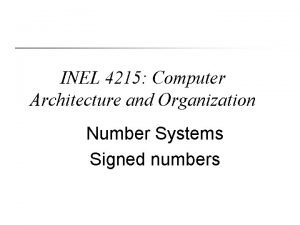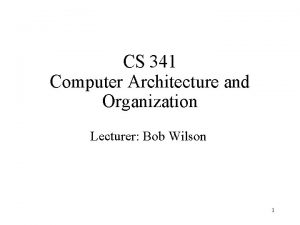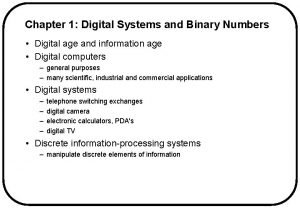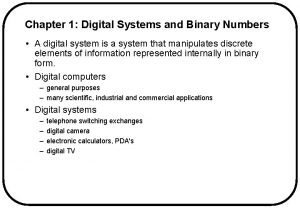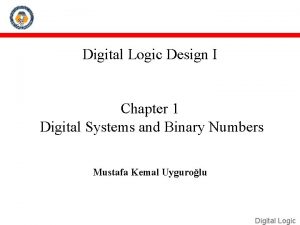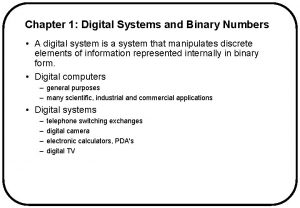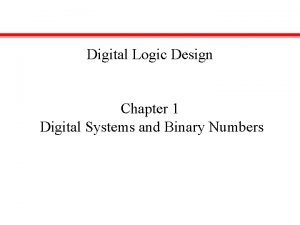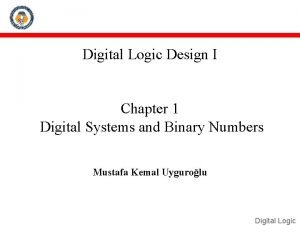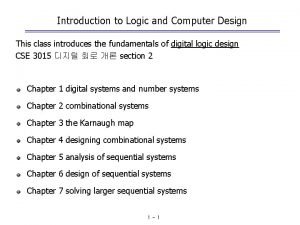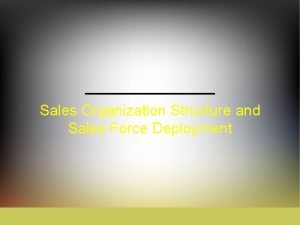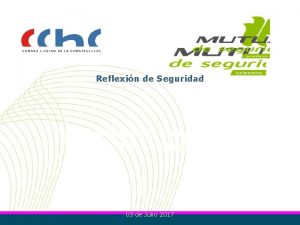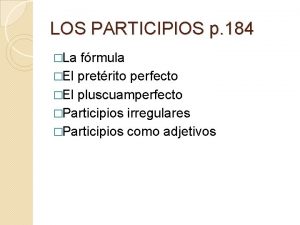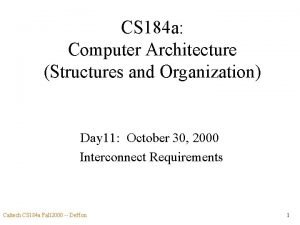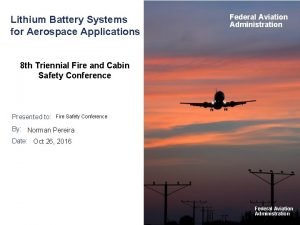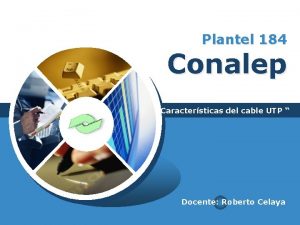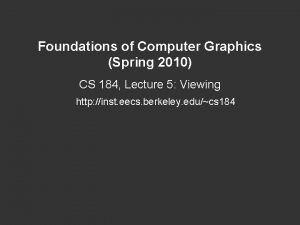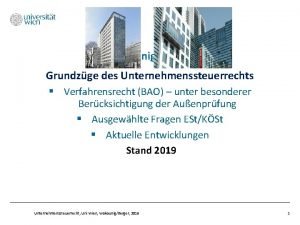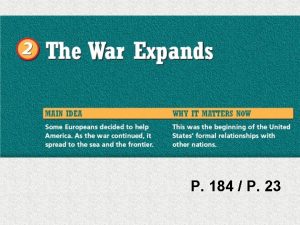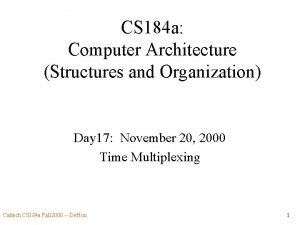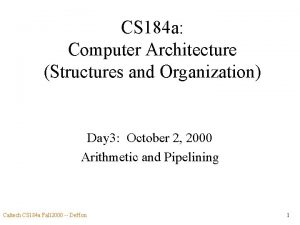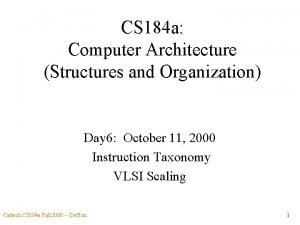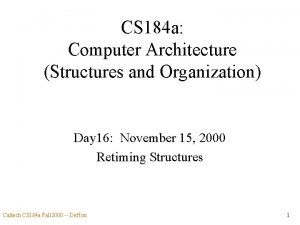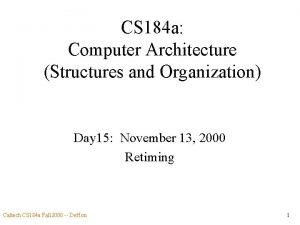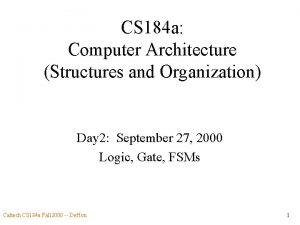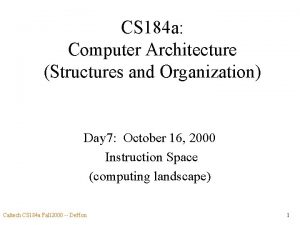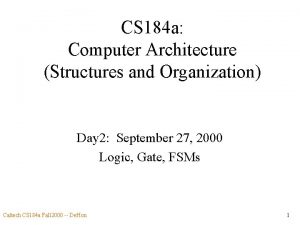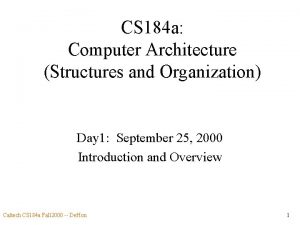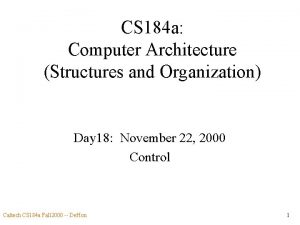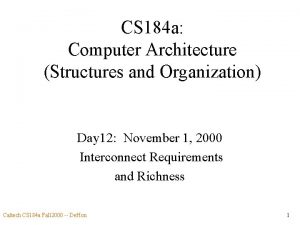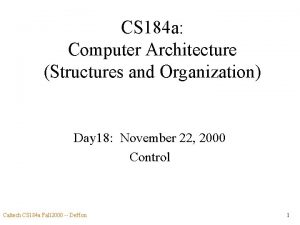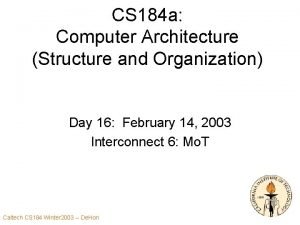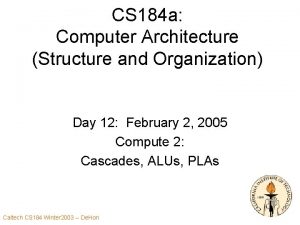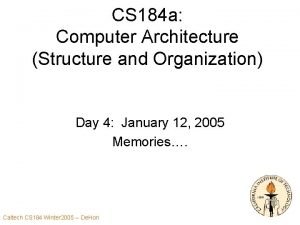CS 184 a Computer Architecture Structures and Organization








































![Big Ideas [MSB Ideas] • Interconnect area dominates logic area • Interconnect requirements vary Big Ideas [MSB Ideas] • Interconnect area dominates logic area • Interconnect requirements vary](https://slidetodoc.com/presentation_image_h2/9633efee286aad34aaaecf8d77262641/image-41.jpg)
![Big Ideas [MSB Ideas] • Two different resources here – compute, interconnect • Balance Big Ideas [MSB Ideas] • Two different resources here – compute, interconnect • Balance](https://slidetodoc.com/presentation_image_h2/9633efee286aad34aaaecf8d77262641/image-42.jpg)
- Slides: 42

CS 184 a: Computer Architecture (Structures and Organization) Day 13: November 6, 2000 Interconnect Richness Caltech CS 184 a Fall 2000 -- De. Hon 1

Last Time • Rent’s Rule Implication • Superlinear growth rate of interconnect p>0. 5 => Area growth O(N 2 p) • Just starting to look at balancing interconnect and logic Caltech CS 184 a Fall 2000 -- De. Hon 2

Today • How rich should interconnect be – specifics of understanding interconnect – methodology for attacking these kinds of questions Caltech CS 184 a Fall 2000 -- De. Hon 3

Now What? • There is structure (locality) • Rent characterizes locality • How rich should interconnect be? – Allow full utilization? – Most area efficient? – Model requirements and area impact Caltech CS 184 a Fall 2000 -- De. Hon 4

Step 1: Build Architecture Model • Assume geometric growth • Pick parameters: Build architecture can tune – F, C – a, p Caltech CS 184 a Fall 2000 -- De. Hon 5

Tree of Meshes • Tree • Restricted internal bandwidth • Can match to model Caltech CS 184 a Fall 2000 -- De. Hon 6

Parameterize C Caltech CS 184 a Fall 2000 -- De. Hon 7

Parameterize Growth (2 1)* => a= 2 Caltech CS 184 a Fall 2000 -- De. Hon (2 2 2 1)* =>a=2(3/4) (2 2 1)* => a=(2*2)(1/3) =2(2/3) 8

Step 2: Area Model • Need to know effect of architecture parameters on area (costs) – focus on dominant components • wires • switches • logic blocks(? ) Caltech CS 184 a Fall 2000 -- De. Hon 9

Area Parameters • Alogic = 40 Kl 2 • Asw = 2. 5 Kl 2 • Wire Pitch = 8 l Caltech CS 184 a Fall 2000 -- De. Hon 10

Switchbox Population • Full population is excessive (next lecture) • Hypothesis: linear population adequate – still to be (dis)proven Caltech CS 184 a Fall 2000 -- De. Hon 11

“Cartoon” VLSI Area Model (Example artificially small for clarity) Caltech CS 184 a Fall 2000 -- De. Hon 12

Larger “Cartoon” 1024 LUT Network P=0. 67 LUT Area 3% Caltech CS 184 a Fall 2000 -- De. Hon 13

Effects of P (a) on Area P=0. 5 Caltech CS 184 a Fall 2000 -- De. Hon P=0. 67 P=0. 75 1024 LUT Area Comparison 14

Effects of P on Capacity Caltech CS 184 a Fall 2000 -- De. Hon 15

Step 3: Characterize Application Requirements • Identify representative applications. – Today: IWLS 93 logic benchmarks • How much structure there? • How much variation among applications? Caltech CS 184 a Fall 2000 -- De. Hon 16

Application Requirements Max: C=7, P=0. 68 Caltech CS 184 a Fall 2000 -- De. Hon Avg: C=5, P=0. 72 17

Benchmark Wide Caltech CS 184 a Fall 2000 -- De. Hon 18

Benchmark Parameters Caltech CS 184 a Fall 2000 -- De. Hon 19

Complication • Interconnect requirements vary among applications • Interconnect richness has large effect on area • What is effect of architecture/application mismatch? – Interconnect too rich? – Interconnect too poor? Caltech CS 184 a Fall 2000 -- De. Hon 20

Interconnect Mismatch in Theory Caltech CS 184 a Fall 2000 -- De. Hon 21

Step 4: Assess Resource Impact • Map designs to parameterized architecture • Identify architectural resource required Compare: mapping to k-LUTs; LUT count vs. k. Caltech CS 184 a Fall 2000 -- De. Hon 22

Mapping to Fixed Wire Schedule • Easy if need less wires than Net • If need more wires than net, must depopulate to meet interconnect limitations. Caltech CS 184 a Fall 2000 -- De. Hon 23

Mapping to Fixed-WS • Better results if “reassociate” rather than keeping original subtrees. Caltech CS 184 a Fall 2000 -- De. Hon 24

Observation • Don’t really want a “bisection” of LUTs – subtree filled to capacity by either of • LUTs • root bandwidth – May be profitable to cut at some place other than midpoint • not require “balance” condition – “Bisection” should account for both LUT and wiring limitations Caltech CS 184 a Fall 2000 -- De. Hon 25

Challenge • Not know where to cut design into – not knowing when wires will limit subtree capacity Caltech CS 184 a Fall 2000 -- De. Hon 26

Brute Force Solution • Explore all cuts – start with all LUTs in group – consider “all” balances – try cut – recurse Caltech CS 184 a Fall 2000 -- De. Hon 27

Brute Force • Too expensive • Exponential work • …viable if solving same subproblems Caltech CS 184 a Fall 2000 -- De. Hon 28

Simplification • Single linear ordering • Partitions = pick split point on ordering • Reduce to finding cost of [start, end] ranges (subtrees) within linear ordering • Only n 2 such subproblems • Can solve with dynamic programming Caltech CS 184 a Fall 2000 -- De. Hon 29

Dynamic Programming • Start with base set of size 1 • Compute all splits of size n, from solutions to all problems of size n-1 or smaller • Done when compute where to split 0, N-1 Caltech CS 184 a Fall 2000 -- De. Hon 30

Dynamic Programming • Just one possible “heuristic” solution to this problem – not optimal – dependent on ordering – sacrifices ability to reorder on splits to avoid exponential problem size • Opportunity to find a better solution here. . . Caltech CS 184 a Fall 2000 -- De. Hon 31

Ordering LUTs • Another problem – lay out gates in 1 D line – minimize sum of squared wire length • tend to cluster connected gates together – Is solvable mathematically for optimal • Eigenvector of connectivity matrix • Use this 1 D ordering for our linear ordering Caltech CS 184 a Fall 2000 -- De. Hon 32

Mapping Results Caltech CS 184 a Fall 2000 -- De. Hon 33

Step 5: Apply Area Model • Assess impact of resource results Caltech CS 184 a Fall 2000 -- De. Hon 34

Resources Area Model Area Caltech CS 184 a Fall 2000 -- De. Hon 35

Net Area Caltech CS 184 a Fall 2000 -- De. Hon 36

Picking Network Design Point Don’t optimize for 100% compute util. (100% yield) …also Caltech CS 184 a Fall 2000 don’t -- De. Hon optimize for highest peak. 37

What about a single design? Caltech CS 184 a Fall 2000 -- De. Hon 38

LUT Utilization predict Area? Single design Caltech CS 184 a Fall 2000 -- De. Hon 39

Methodology • • Architecture model (parameterized) Cost model Important task characteristics Mapping Algorithm – Map to determine resources • Apply cost model • Digest results – find optimum (multiple? ) – understand conflicts (avoidable? ) Caltech CS 184 a Fall 2000 -- De. Hon 40
![Big Ideas MSB Ideas Interconnect area dominates logic area Interconnect requirements vary Big Ideas [MSB Ideas] • Interconnect area dominates logic area • Interconnect requirements vary](https://slidetodoc.com/presentation_image_h2/9633efee286aad34aaaecf8d77262641/image-41.jpg)
Big Ideas [MSB Ideas] • Interconnect area dominates logic area • Interconnect requirements vary – among designs – within a single design • To minimize area – focus on using dominant resource (interconnect) – may underuse non-dominant resources (LUTs) Caltech CS 184 a Fall 2000 -- De. Hon 41
![Big Ideas MSB Ideas Two different resources here compute interconnect Balance Big Ideas [MSB Ideas] • Two different resources here – compute, interconnect • Balance](https://slidetodoc.com/presentation_image_h2/9633efee286aad34aaaecf8d77262641/image-42.jpg)
Big Ideas [MSB Ideas] • Two different resources here – compute, interconnect • Balance of resources required varies among designs (even within designs) • Cannot expect full utilization of every resource • Most area-efficient designs may waste some compute resources (cheaper resource) Caltech CS 184 a Fall 2000 -- De. Hon 42
 Organization and architecture difference
Organization and architecture difference Computer organization and architecture 10th solution
Computer organization and architecture 10th solution Virtual lab for computer organization and architecture
Virtual lab for computer organization and architecture Introduction to computer organization and architecture
Introduction to computer organization and architecture Computer organization & architecture: themes and variations
Computer organization & architecture: themes and variations Computer organization and architecture 10th edition
Computer organization and architecture 10th edition Computer organization and architecture william stallings
Computer organization and architecture william stallings Risc vs cisc example
Risc vs cisc example Ones complement
Ones complement Computer architecture and organization
Computer architecture and organization Process organization in computer organization
Process organization in computer organization Buses in computer architecture
Buses in computer architecture Instruction set architecture in computer organization
Instruction set architecture in computer organization Memory organisation in computer architecture
Memory organisation in computer architecture Homologous
Homologous Basic structure of a computer
Basic structure of a computer Design of basic computer
Design of basic computer Basic computer design
Basic computer design Bcd addition of 184 and 576
Bcd addition of 184 and 576 Bcd addition of 184 and 576
Bcd addition of 184 and 576 Bcd addition of 184 and 576
Bcd addition of 184 and 576 Bcd addition of 184 and 576
Bcd addition of 184 and 576 Bcd addition of 184 and 576
Bcd addition of 184 and 576 Bcd addition of 184 and 576
Bcd addition of 184 and 576 Using 10's complement subtract 72532-3250
Using 10's complement subtract 72532-3250 Bcd addition of 184 and 576
Bcd addition of 184 and 576 Point by point vs block organization
Point by point vs block organization Sales force organization structure
Sales force organization structure Ales force structure
Ales force structure Bus interconnection in computer architecture
Bus interconnection in computer architecture Articulo 184 del codigo del trabajo
Articulo 184 del codigo del trabajo Haber en participio
Haber en participio Signing naturally homework 4.1 minidialogue answers
Signing naturally homework 4.1 minidialogue answers 4-sinf ona tili fanidan yillik dars ishlanma
4-sinf ona tili fanidan yillik dars ishlanma 4 184 joules
4 184 joules Cs 184
Cs 184 Cs 184
Cs 184 Ac 20-184
Ac 20-184 Dispositivos disimiles y similares
Dispositivos disimiles y similares Cs 184 berkeley
Cs 184 berkeley (7 − 13) · (192 − 184).
(7 − 13) · (192 − 184). 184 bao
184 bao Tck 184
Tck 184








